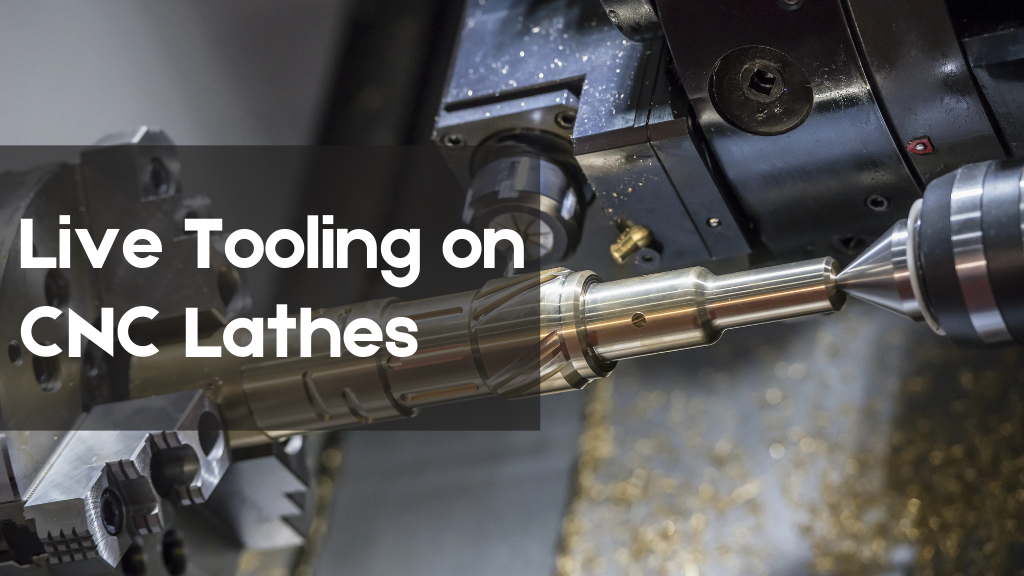In modern manufacturing, precision and efficiency are crucial. One technological advancement that has significantly transformed machining processes is the integration of live tooling on CNC lathes. This innovation allows the execution of multiple operations such as milling, drilling, and tapping on a single machine setup. The result is improved productivity and reduced operational costs.
This guide explores the intricacies of live tooling on CNC lathes. It examines its functionality, benefits, applications, and key considerations for implementation. Manufacturers can gain insights into how to optimize their machining processes by understanding live tooling systems.
What Is Live Tooling on CNC Lathes
Live tooling refers to powered tool stations installed on a CNC lathe’s turret. Unlike traditional lathes where tools are static and only the workpiece rotates, live tooling enables the tools themselves to rotate. This capability facilitates additional machining operations beyond standard turning.
How Live Tooling Works
In a CNC lathe equipped with live tooling, powered tool stations allow tools to rotate independently of the spindle. These tools can move in multiple axes, enabling complex operations such as milling, drilling, tapping, and contouring. CNC programs control the activation and movement of the live tools. The synchronization of the live tools with the spindle and machine movements is essential for accurate and efficient machining.
This arrangement transforms a conventional lathe into a versatile machining center capable of handling multiple operations in a single setup.
Advantages of Live Tooling
Live tooling offers numerous benefits for CNC lathe operations, improving efficiency, precision, and flexibility. By combining multiple machining tasks into one setup, it reduces the need for transferring workpieces between machines. This integration streamlines workflow and saves valuable production time. Additionally, live tooling supports more complex geometries, enabling operations that would otherwise require multiple setups. Overall, it enhances both productivity and part quality.
1. Enhanced Machining Capabilities
With live tooling, CNC lathes can perform milling, drilling, and tapping in a single setup. This eliminates the need to move the workpiece to different machines, reducing handling errors. Operators can machine intricate geometries efficiently without compromising precision. It also allows for simultaneous operations on multiple features. The result is faster production with improved workflow consistency.
2. Improved Accuracy and Consistency
Fewer setups and reduced handling minimize alignment errors during machining. This leads to higher precision parts with consistent quality across batches. Industries requiring tight tolerances, such as aerospace and medical, benefit significantly. The reduced chance of misalignment lowers scrap rates and rework. Consistency in part dimensions ensures reliable assembly and performance.
3. Reduced Setup Times
Combining several operations in one setup shortens overall production cycles. Machine downtime is minimized, and fewer setups mean operators spend less time repositioning workpieces. This leads to faster completion of projects and higher throughput. Single-setup operations also reduce the potential for human error. Efficient use of the machine maximizes its output capabilities.
4. Cost Efficiency
Although live tooling CNC lathes have higher upfront costs, they save money in the long term. Fewer setups reduce labor requirements and production time. Less reliance on multiple machines lowers overhead and maintenance expenses. High efficiency reduces waste, scrap, and the need for additional tooling. Overall, live tooling provides a strong return on investment for manufacturers.
5. Increased Flexibility
Live tooling allows manufacturers to adapt quickly to design changes or custom orders. Programs can be adjusted without reconfiguring the machine extensively. This makes it ideal for prototyping or small batch production. Operators can switch between operations smoothly while maintaining accuracy. Flexibility enhances responsiveness to market demands and client requirements.
Types of Live Tooling on CNC Lathes
Live tooling systems are categorized based on their orientation and specific function. Understanding the different types helps operators select the most suitable tool for a given machining task. Choosing the correct tooling setup ensures better precision and smoother workflow. It also reduces the number of setups required during production. Proper selection ultimately enhances both efficiency and accuracy in CNC operations.
-
Radial Live Tools
Radial live tools are mounted perpendicular to the spindle axis of the CNC lathe. These tools are primarily used for machining along the diameter of the workpiece. Typical applications include face milling, slotting, and external contouring. They are especially useful when working on cylindrical parts with complex designs. By eliminating multiple setups, they save time and improve consistency.
-
Axial Live Tools
Axial live tools are positioned parallel to the spindle axis of the machine. They are commonly used for drilling, reaming, and tapping operations along the workpiece length. This makes them highly effective for creating holes, threads, and other longitudinal features. Operators rely on axial tools for faster production in a single setup. Their design supports smooth integration into complex machining cycles.
-
C-Axis Live Tools
C-axis live tools add a rotary axis to the standard X and Z movements in CNC lathes. This addition allows precise angular positioning for more advanced machining operations. Common applications include helical milling, angled drilling, and multi-surface machining. They are especially valuable for parts requiring intricate geometrical shapes. With C-axis tools, manufacturers can achieve higher accuracy and greater flexibility.
Applications of Live Tooling
Live tooling is essential for industries requiring complex parts with multiple features. It allows several machining operations in a single setup, saving time and reducing errors. This approach improves efficiency, ensures higher precision, and maintains consistent production quality. By minimizing handling and transfers, it streamlines the workflow and enhances overall performance.
-
Aerospace
Aerospace components often feature intricate geometries and require tight tolerances. Live tooling enables precise milling, drilling, and tapping in a single setup. This reduces production time while maintaining consistent quality across all parts. It also minimizes errors, ensuring reliable performance in critical aerospace applications.
-
Automotive
Automotive parts such as shafts, housings, and brackets frequently require multiple machining operations. Live tooling reduces the need for multiple setups, saving time and improving efficiency. It ensures high accuracy, lowers labor requirements, and decreases downtime in large-scale manufacturing environments.
-
Medical Devices
Surgical instruments and implants demand high precision and intricate features. Live tooling allows multiple operations in a single setup while maintaining strict tolerances. This ensures safer, high-quality products while reducing errors and increasing production speed in medical manufacturing.
-
General Manufacturing
For custom parts and prototypes, live tooling provides both speed and flexibility. Quick transitions between operations reduce downtime and improve efficiency. This makes it ideal for small batch production or projects with frequent design changes, allowing manufacturers to meet deadlines effectively.
Selecting the Right Live Tooling on CNC Lathes
Choosing a live tooling CNC lathe requires evaluating several factors to achieve the best results. The right machine enhances precision, efficiency, and flexibility in complex machining. Careful consideration of compatibility, operator skills, maintenance needs, and costs ensures maximum performance and long-term value.
-
Machine Compatibility
Not all CNC lathes are equipped for live tooling operations. The machine must support powered tool stations and multi-axis movement to function effectively. Reviewing manufacturer specifications helps determine whether the lathe can handle advanced tooling tasks without operational limitations.
-
Operator Training
Operators must have proper training to fully utilize live tooling systems. Knowledge of multi-axis machining, synchronization, and CNC programming is essential. Well-trained staff can reduce errors, improve production speed, and ensure safer, more accurate machining processes.
-
Maintenance Requirements
Live tooling systems include additional components that demand regular upkeep. Bearings, motors, and tool holders require periodic inspection and servicing. Consistent maintenance prevents breakdowns, extends tool life, and guarantees consistent, high-quality machining performance.
-
Cost-Benefit Analysis
While live tooling systems often come with higher initial costs, they reduce setup times and labor needs. They also minimize the need for additional machines, improving overall productivity. A detailed cost-benefit review helps confirm that the investment meets both production efficiency and financial goals.
Best Practices for Live Tooling on CNC Lathes
Implementing best practices is essential for achieving consistent performance and long tool life in live tooling systems. Following guidelines for maintenance, tool selection, programming, and operator training maximizes efficiency and ensures precise machining.
-
Regular Maintenance
Routine maintenance keeps live tooling systems operating at peak performance. Inspecting tool holders, motors, and bearings regularly prevents premature wear. Scheduled upkeep also reduces the risk of unexpected downtime and costly repairs, ensuring smooth production.
-
Tool Selection
Choosing the right tools for each operation improves machining efficiency and reduces wear. High-quality, balanced tools minimize vibration, maintain cutting accuracy, and enhance part quality. Proper selection also prolongs the lifespan of both the tools and the machine.
-
Efficient Programming
Optimized CNC programs reduce unnecessary tool changes and movements. Efficient programming increases productivity while minimizing stress on the machine and tools. This results in smoother operations, improved part consistency, and longer equipment life.
-
Operator Training
Continuous training ensures operators understand the capabilities and limits of live tooling systems. Skilled operators can prevent errors, improve workflow, and maintain safety standards. Proper training also ensures precise, high-quality machining and optimal system performance.
Real World Example of Live Tooling
A mid-sized automotive supplier implemented a live tooling CNC lathe for producing precision shafts and housings. Previously, each part required two separate setups, increasing production time and the risk of errors. With live tooling, all operations were completed in a single setup, reducing production time by thirty-five percent. Scrap due to misalignment decreased significantly, improving overall efficiency and product quality. This case highlights the tangible benefits of live tooling in industrial applications.
Advanced Techniques
Live tooling systems enable advanced machining strategies that enhance precision, efficiency, and versatility. By combining multiple operations in one setup and integrating automation, manufacturers can produce complex parts faster. These techniques also reduce machine handling and improve overall workflow, ensuring consistent high-quality results.
-
Multi Feature Machining
Combining turning, drilling, and milling in a single setup allows for the creation of complex parts with grooves, threads, and slots. This reduces the need for multiple machines and setups. It saves time, lowers labor costs, and improves production efficiency while maintaining high accuracy.
-
Synchronization
Synchronizing live tools with the spindle allows precise operations like thread milling and helical drilling. Proper synchronization minimizes tool wear and ensures consistent part quality. It enhances repeatability, which is vital for high-volume production. This precision is crucial for components with tight tolerances. Effective synchronization improves efficiency and reduces rework.
-
Custom Fixture Design
Custom fixtures are often necessary when using live tooling for specific parts. Well-designed fixtures enhance part stability and minimize vibration during machining. They help maintain consistent alignment and ensure precise positioning. This is particularly important for irregular, delicate, or small components. Proper fixture design improves overall machining accuracy and part quality.
-
Automation Integration
Integrating live tooling CNC lathes with robotic loaders and unloaders minimizes labor requirements and increases throughput. Automation reduces human error and ensures consistent quality across production runs. It is particularly valuable for high-volume manufacturing and small-batch customization.
Conclusion
Live tooling on CNC lathes represents a significant advancement in machining technology. It enhances capabilities, improves efficiency, and provides cost savings. By performing multiple operations in a single setup, manufacturers save time, reduce costs, and increase precision. Proper implementation, maintenance, and operator training ensure that live tooling delivers maximum value.
Investing in live tooling CNC lathes can transform production processes, making them more efficient, flexible, and capable of handling complex machining tasks. Manufacturers looking to stay competitive should consider integrating live tooling into their operations to achieve higher productivity and better quality outcomes.
Frequently Asked Questions
What is the primary benefit of live tooling on CNC lathes
The main benefit is the ability to perform multiple machining operations such as milling, drilling, and tapping on a single machine setup, which reduces setup time and improves efficiency.
Can all CNC lathes support live tooling
No, only CNC lathes designed with powered tool stations and multi-axis capabilities can support live tooling systems.
How does live tooling improve part accuracy
By reducing setups and handling, live tooling minimizes alignment errors and produces more consistent and precise parts.
Which industries benefit most from live tooling on CNC Lathes
Industries such as aerospace, automotive, medical device manufacturing, and general precision manufacturing benefit the most from live tooling.
How should live tooling systems be maintained
Regular inspection of tool holders, motors, and bearings is essential. Routine maintenance ensures consistent performance and prolongs the lifespan of the equipment.




